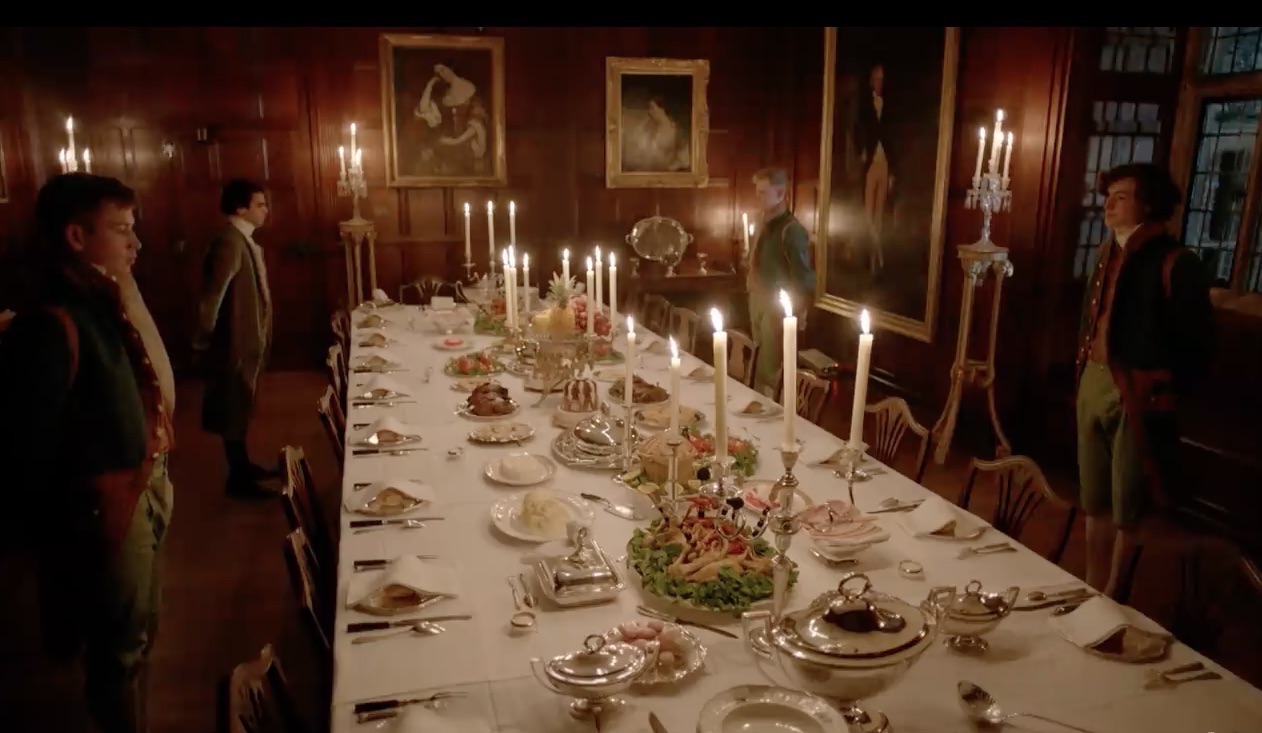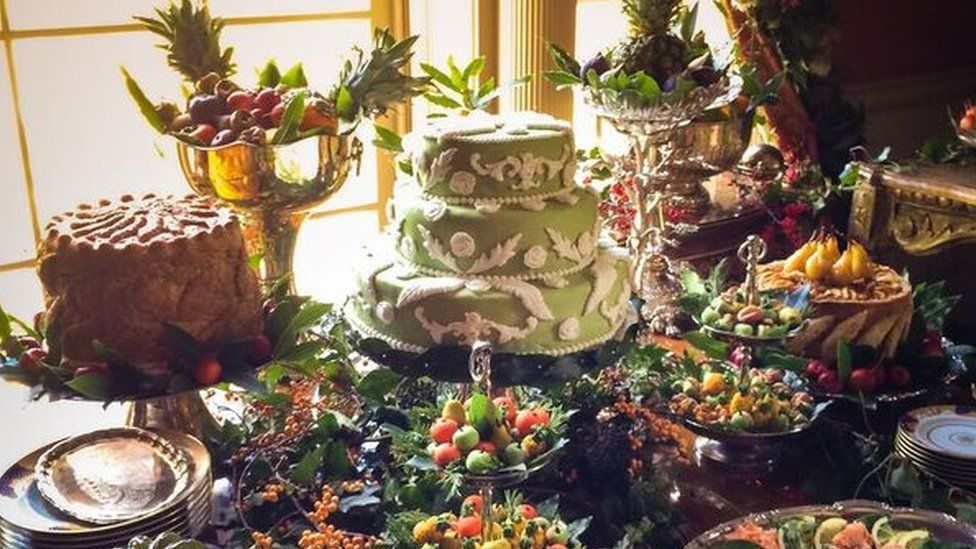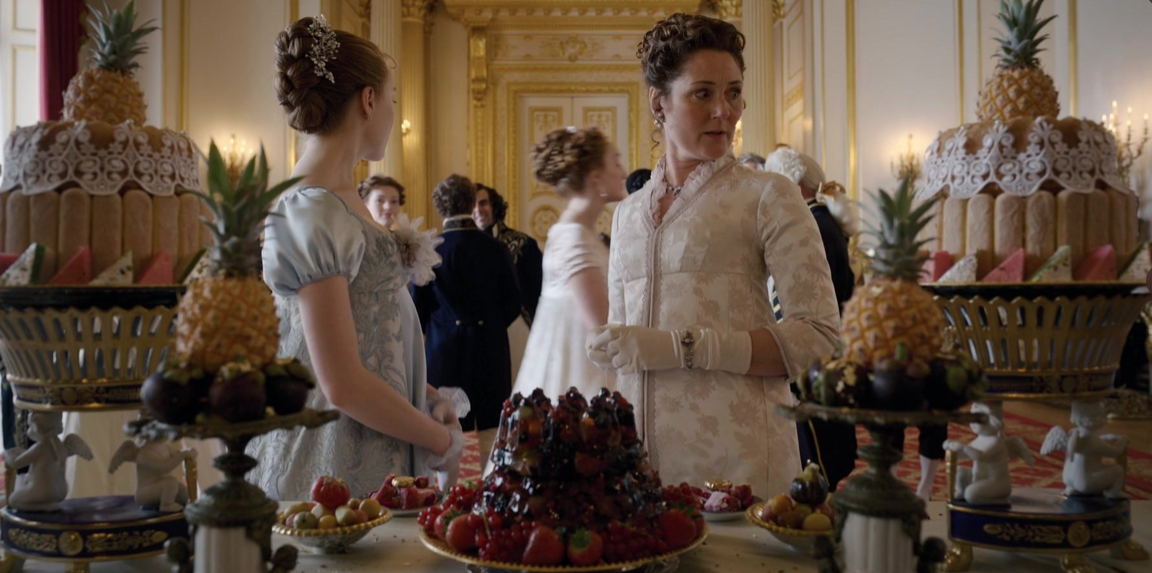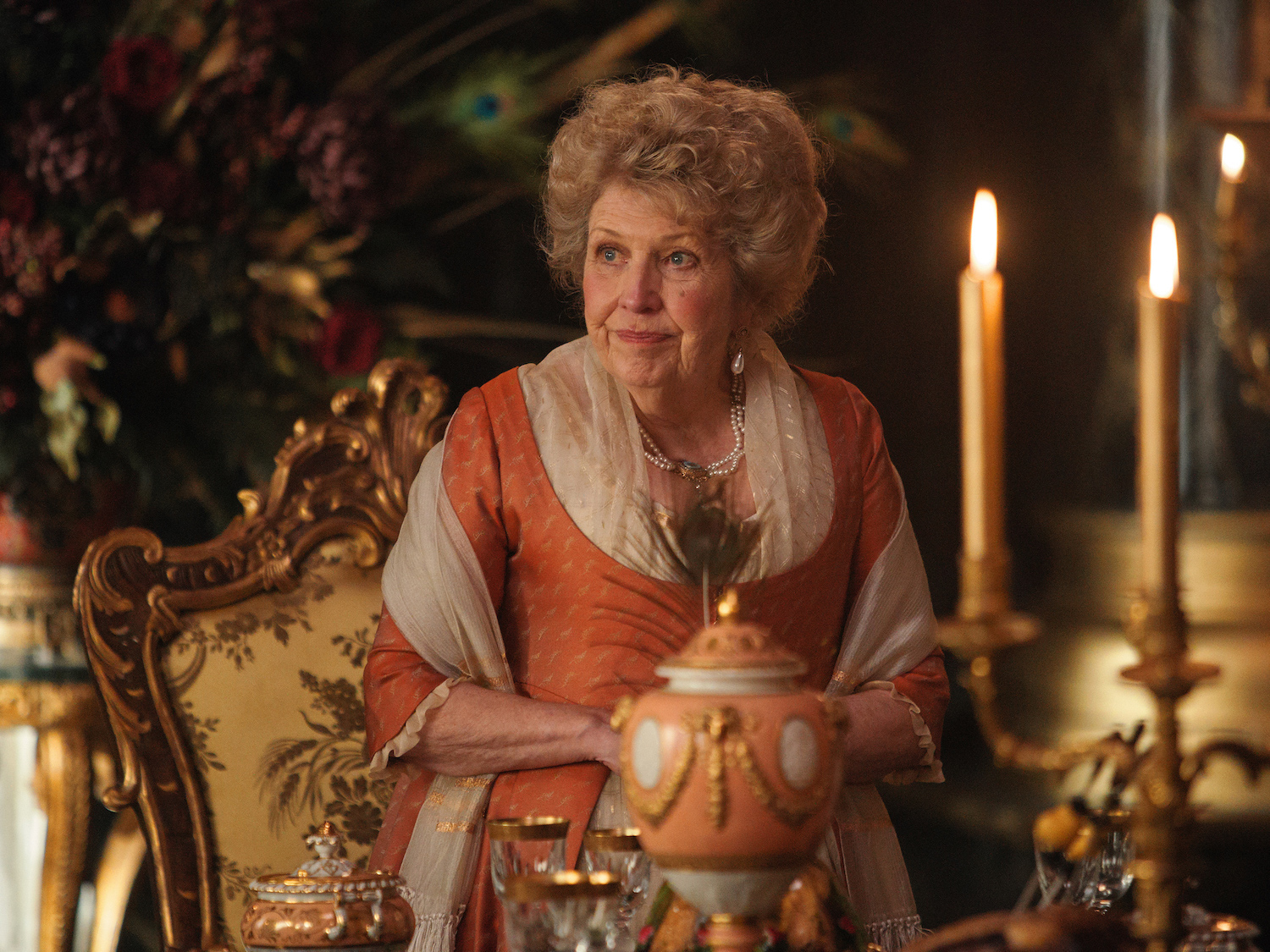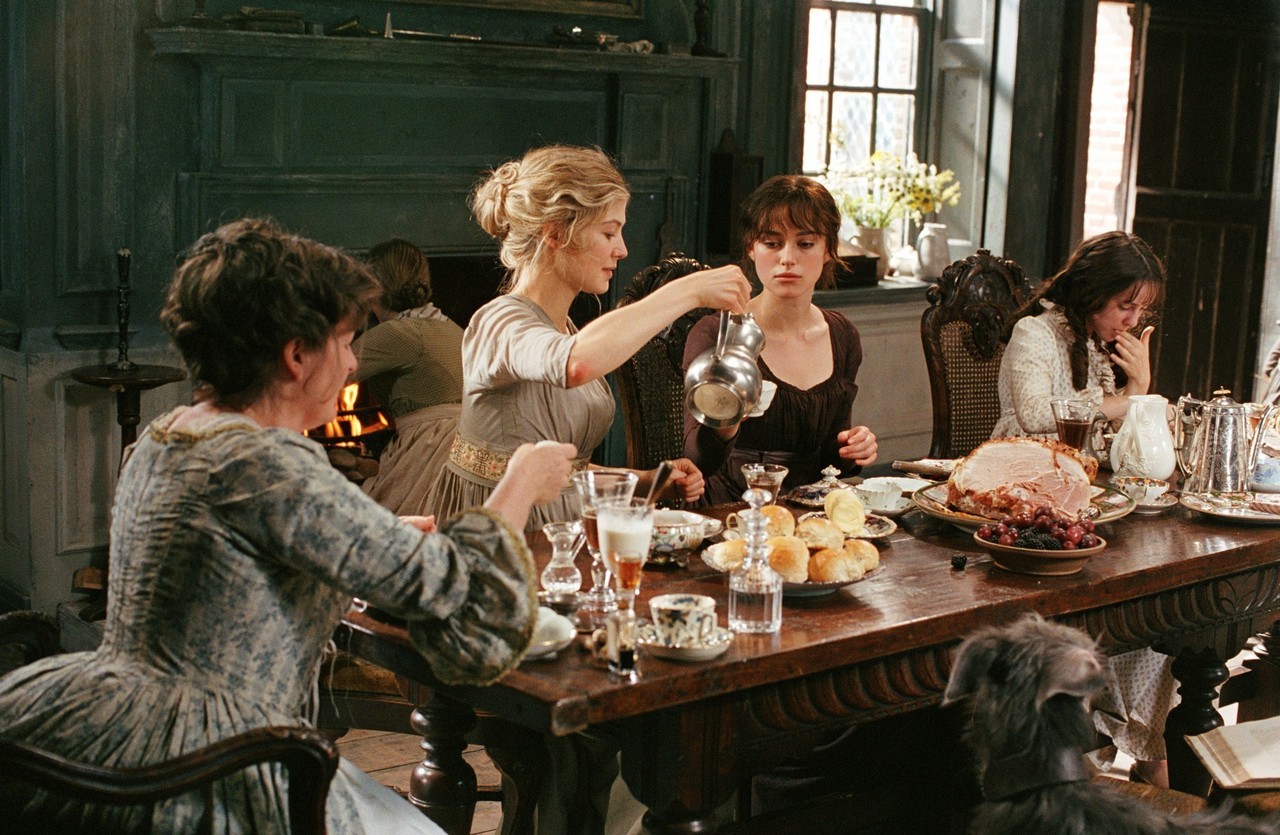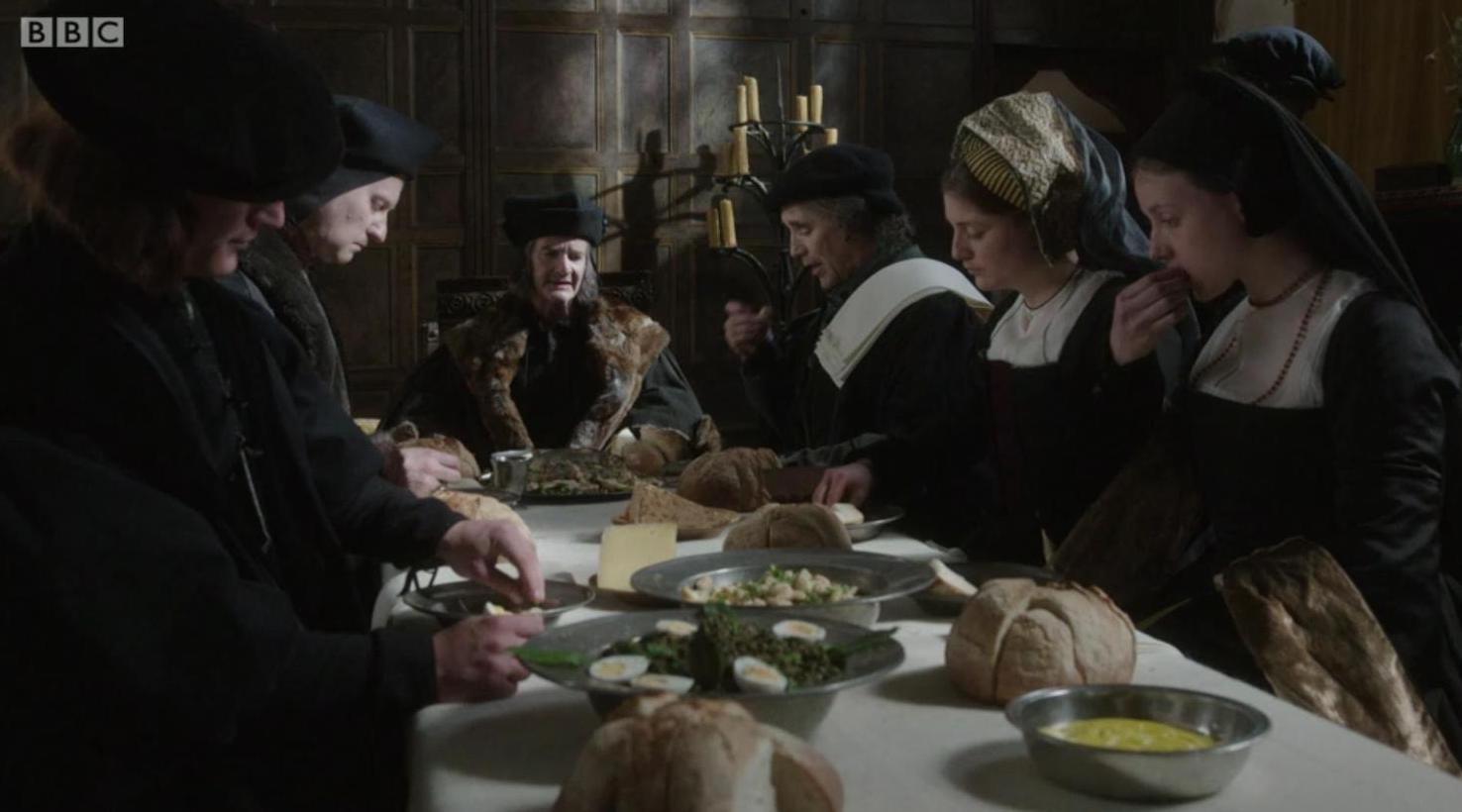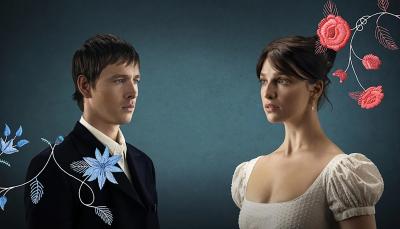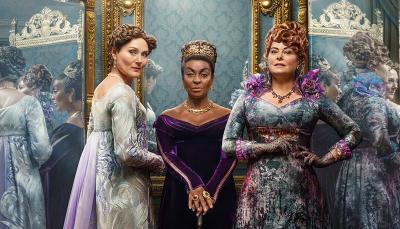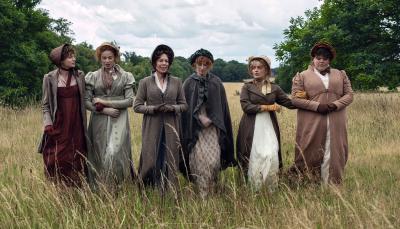Feasts for the Eyes – Food in Period Piece Adaptations
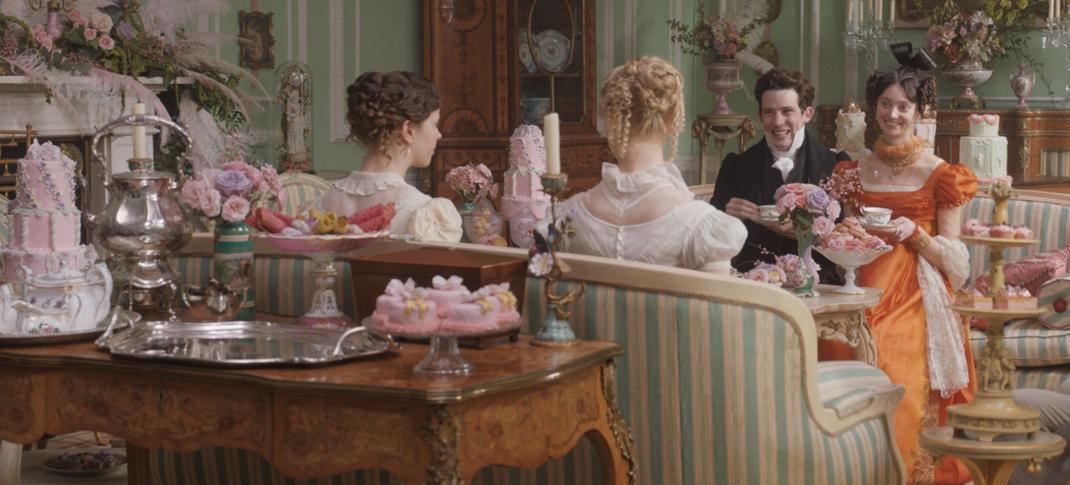
Harriet (Mia Goth) and Emma (Ana Taylor-Joy) host Mr. Elton (Josh O'Connor) and Mrs. Elton (Tanya Reynolds) at a tea party.
© Focus Features
Since we’re only a few weeks from Jane Austen’s birthday (December 16), let’s start with a BBC documentary, Pride and Prejudice: Having a Ball, currently available on Acorn TV. Released in 2013, to coincide with the 200th anniversary of the publication of Pride and Prejudice, the documentary shows a re-creation of the ball at Netherfield. The location is Chawton House, owned by Austen’s brother Edward Knight, a short walk away from her own house and one she would have known well. Historians –– specialists in food, dance, music, etiquette, and costume –– collaborated to make the event as authentic as possible. There’s a lot of documentation on food and preparation, but there are also considerable gaps in our knowledge. As food historian Ivan Day points out, the art of dining å la francaise, the norm for Austen’s time, is now lost since plated service (å la russe) replaced it in the mid-nineteenth century.
Dinner å la francaise was a feast for the eye and the palate, featuring many elaborately decorated and presented dishes, both savory and sweet, arranged symmetrically on the table simultaneously. Day and his crew prepared sixty-three dishes (forty were sweet), which were served in two removes (courses). Instead of hovering discreetly out of sight, the footmen are very much in evidence throughout the meal, assisting guests in serving themselves and those seated nearby. Dinner becomes a rowdy, sociable experience, with much reaching and stretching over the table. The footmen were advised: “You’re all professional waiters. So [we] will try to make you unlearn everything you’ve learned because this will be completely different to any table you’ve ever served.”
And the food? Rich, surprising, delicious, complex. Regency diners were no strangers to snout-to-tail eating. Food historian Ivan Day enthuses about roast chicken Regency style:
A lot of people actually enjoyed eating the head of the chicken because it cooks to a wonderful mush, and you just put it in your mouth and suck the eyes and the brain out through the beak. It’s a wonderful gastronomic experience.
Above all, entertaining was an excuse for the host to show off their wealth with a lavish dining experience, and as we all know, get a group of people around a table full of food, and just about anything can, and does happen. So let’s look at some food scenes in Austen (and other) adaptations.
Food in historical drama, particularly that of the upscale dining rooms of the aristocracy, always looks luscious, but –– spoiler alert –– it may not be real or even edible. As with costumes, often what you see is the creation of an illusion. The food has to last through multiple takes so it can’t collapse or melt. The food expert and food stylist on staff may have to cook –– or create –– off-site and may not have access to historic equipment. Chawton’s sturgeon (an endangered species obtained from a fish farm) was too big to fit into the catering oven on site and had to undergo surgery, patched up with garnishes. Food stylist for Poldark, Genevieve Taylor, had a similar problem with a large, whole salmon.
This arrangement from Poldark looks gorgeous, but how much is real? The pies are hollow, and built-in Quality Street tins (a traditional British holiday candy favorite that no one really seems to like very much). The green and white Wedgwood-style cake is styrofoam with frosting. While acknowledging that this is assembled only for display and photography, the presence of plates suggests a buffet set up, a fashion adopted much later in the mid-nineteenth century. But otherwise, it’s impressive, it mixes sweet and savory, and the decoration is spectacular.
As you’d expect, Netflix’s Bridgerton features wonderfully over-the-top, colorful food, although sadly the dining room scenes show little rowdy behavior. This table of desserts features a jelly dessert, or flummery, to give it its correct term, front center. Regency aristocrats really loved multi colored, elaborate flummeries, and the more wobbly the better. Watching Ivan Day ease a flummery from its mould is worthy of Call the Midwife, and the shakes and shivers on the way to the dining room are equally exciting. The symmetrically arranged table features four pineapples, including two stuck on top of big cakes, and yes, big cakes were a thing too.
Talking of pineapples, one of the strongest, and most controversial, scenes in Sanditon is the luncheon given by Lady Denham (Anne Reid) to allegedly honor Miss Lambe. The pineapple required enormous wealth and resources to be domestically grown, and, as the scene revealed, was seen as a symbol not only of conspicuous consumption, but of the Slave Trade itself. Georgiana, well aware of the fruit’s significance, combats Lady Denham’s racism and arrogance, and it’s no surprise that when the pineapple is cut it’s full of worms and decay.
Back to Austen, and a quieter scene, the Bennets at breakfast in the 2005 Pride and Prejudice. Let’s call this one the morning after the feast. For a movie that was sometimes spectacularly wacko, this scene gets so much right about the period. It shows the easy informality of the Bennet household (admittedly, they are rather too informal at times). Beer is served for breakfast, which both Mrs. Bennet and Jane drink. Although a servant is present, she is busy tending to the fire, and Jane pours Elizabeth’s coffee (or tea?). The table holds bread rolls and a ham, and you have the impression this large ham will be around for some time, appearing at various meals and whittled away in the kitchen. For once, the Bennet women are not bickering.
It’s far from Jane Austen, or a feast, but Wolf Hall had one spectacularly good scene with food in Season 1, Episode 2, where Thomas Cromwell (Mark Rylance) dines with Sir Thomas More (Anton Lesser). Despite his status and wealth as Chancellor of the Exchequer, More prefers a conspicuously ascetic lifestyle, even when his guests include the Spanish ambassador. It may be Lent, or it may just be More being More, but his table is simple to an extreme. It is dominated by bread, basic everyday loaves of wheat and rye. There are plates of greens, and on the nearest one, some hard-boiled eggs, but not nearly enough for everyone at the table. Another one holds what may be pieces of fish among the salad. There is also a bowl of yellow pottage, a vegetable-based stew. Even allowing for the fact that Cromwell arrived late to the meal, it’s slim pickings.
I’ve often wondered why there isn’t nearly as much interest in authentic-looking food as there is in historically-correct costumes in historical drama, although historical food research and cooking has an enthusiastic geekery. Just about every historical house you'll visit will manage an open hearth cooking demo, and usually has an elaborate meal set up in the dining room (it's not real!). And if you ever have the chance to sample food from Austen's time, and parmesan ice-cream is available, go for it. It sounds weird, but it's delicious.

